Table of Contents[Hide][Show]
- Nutrivore Score for Halibut – 523
- Halibut Nutrition Facts
- Halibut Nutrition Varies With Cooking
- Halibut Nutrition Varies With Type
Health Benefits of Halibut Nutrients+−
- Halibut Provides 95% DV Selenium
- Halibut Provides 89% DV EPA+DHA
- Halibut Provides 53% DV Vitamin B12 (Cobalamin)
- Halibut Provides 47% DV Vitamin B3 (Niacin)
- Halibut Provides 21.3 g of Protein
- Halibut Provides 39% DV Vitamin B7 (Biotin)
- Halibut Provides 37% DV Vitamin B6 (Pyridoxine)
- Halibut Provides 1.7 mg of CoQ10
- Halibut Provides 27% DV Vitamin D
- Halibut Provides 22% DV Phosphorus
- How Much Halibut Should We Eat Per Day?

Halibut is a popular sport and culinary fish enjoyed in many parts of the world all year-long. However, the name halibut actually comes from “haly” (meaning holy) and “butte” (meaning flat fish) – a reference to the common historical practice of eating this fish on holy days.
At birth halibut swim like other fish but at around 6 months one eye migrates to the other side of their head and they start to swim on their side (with both eyes on top)!
In actuality, halibut does not refer to one specific fish but is the common name given to large flatfish belonging to different genera which live in the North Atlantic, Pacific and Arctic oceans, occupying waters belonging to Canada, Japan, Russia, and the United States – the most well-known being the Atlantic, Greenland and Pacific halibut. As the term flatfish suggests, halibut are actually flattened fish that swim on their side. Interestingly, at birth these fish swim just like other fish but at around 6 months one eye migrates to the other side of their head and that’s when they start to swim on their side (with both eyes on top)! Halibut are considered a whitefish, which is a general term referring to several species of white-fleshed, mild-flavored fish, including cod, haddock, flounder, hake, sole, snapper, tilapia, pollock, whiting and most freshwater fish. These fish tend to live near the seafloor and only contain oils in their liver (in contrast to oily-fleshed fish like salmon). Like other whitefish, halibut are considered ground fish, preferring to live on or near the bottom of the sea where they camouflage with their surroundings (dark brown and mottled on the top like the ocean floor and whitish underneath to resemble light from above). In general, the male fish are smaller, not growing much above 100 pounds, while the females who live longer, can grow to 600 pounds or more (that’s a lot of filets!). In fact, the Atlantic halibut is considered the world’s largest flatfish. It’s not surprising then, that when it comes to their diet, halibut aren’t picky – eating pretty much any fish or animal that will fit in their mouth (including other halibut), placing them near the top of the marine food chain. These fish can live to be 50 years old and interestingly, their age can be determined by analyzing their ear bone which forms annual growth rings similar to that of a tree.
Halibut can live to be 50 years – their age can be determined by analyzing their ear bone which forms annual growth rings similar to that of a tree!
Halibut was, and still is, an important food for the Indigenous peoples of North America. They have also been fished commercially in the North Pacific since the late 19th century, an industry which is still going strong today – in fact, it is one of the largest and most lucrative in the area. However, the Atlantic halibut population is endangered as a result of overfishing which is why responsible consumers should opt for Pacific. Because of their huge size, halibut provide large fillets which can be cooked as steaks. This fish is popular for its dense, firm texture and mild taste, which is easy to cook and works well prepared in various ways, so why not try some for dinner tonight, just for the “halibut!”
Learn What Foods to *ADD* to Your Diet
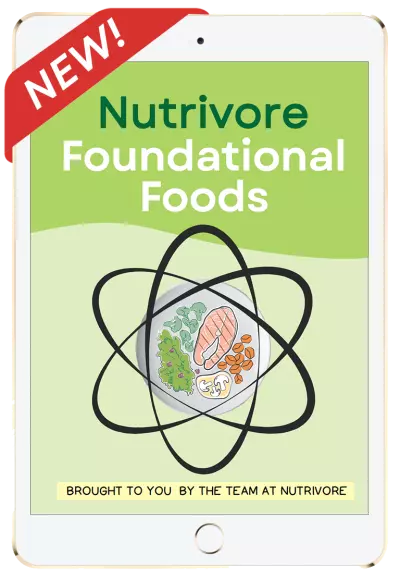
Nutrivore Foundational Foods
Learn what makes the 12 Nutrivore foundational food families nutritionally unique, their health benefits, which options are the most nutrient dense, how much of them to eat, plus various fun facts, practical pointers, and busting of common myths.
This very helpful resource will introduce you to new foods and expand your nutrition knowledge, making food choices easier!
Buy now for instant digital access.
Nutrivore Score for Halibut – 523
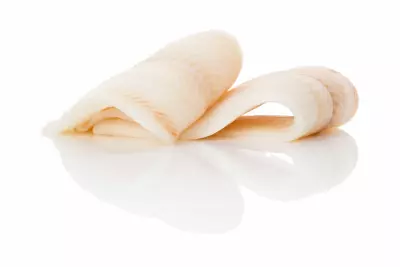
Halibut has a Nutrivore Score of 523, making it a high nutrient-dense food! Plus, it is a low-carb food; halibut has 0 grams of net carbs per 115 gram serving!
Per serving, halibut is a best source (>50% daily value) of EPA+DHA, selenium, and vitamin B12 (cobalamin); an excellent source (20-50% daily value) of coQ10, phosphorus, protein, vitamin B3 (niacin), vitamin B6 (pyridoxine), vitamin B7 (biotin), and vitamin D; and a good source (10-20% daily value) of choline, iodine, and potassium.
Ditch Diets. Embrace Nutrients. Start with These 5 Free Guides.
Sign up for the free weekly Nutrivore Newsletter and get 5 high-value downloads—delivered straight to your inbox—that make healthy eating simple and sustainable.

Halibut Nutrition Facts
One serving of halibut is standardized to 115 grams (4 ounces). For reference, a typical fillet of halibut weights 408 grams, which is equivalent to 3.5 servings! When you cook halibut, it reduces in volume by approximately 20%: 100 grams of raw halibut is roughly equivalent to 82 grams cooked halibut.
Halibut Nutrition Facts Per Serving
| Halibut, raw | Nutrivore Score: 523 | Nutrient Density: High |
|---|---|---|
| Serving Size: 4 ounces (115 grams) | Protein: 21.3 grams | Net Carbohydrates: 0.0 grams |
| Calories: 105 | Total Fat: 1.5 grams | Dietary Fiber: 0.0 grams |
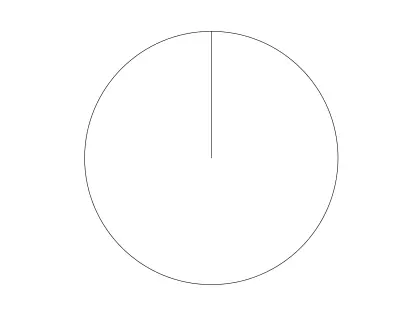
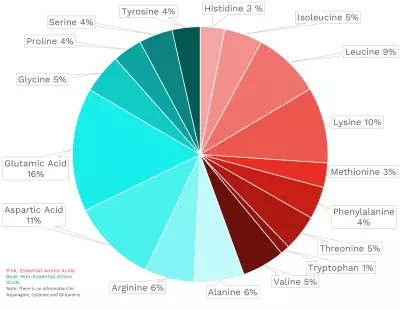
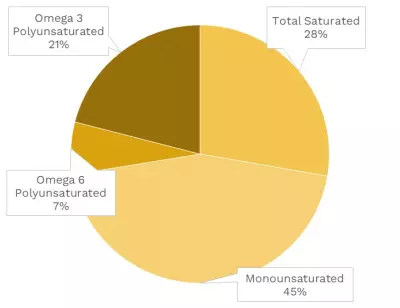
| VITAMINS | ||
|---|---|---|
| Vitamin A | 23.0 μg RAE | 3% DV |
| Vitamin B1 (Thiamin) | 57.5 μg | 5% DV |
| Vitamin B2 (Riboflavin) | 34.5 μg | 3% DV |
| Vitamin B3 (Niacin) | 7.5 mg | 47% DV |
| Vitamin B5 (Pantothenic Acid) | 0.4 mg | 8% DV |
| Vitamin B6 (Pyridoxine) | 630.2 μg | 37% DV |
| Vitamin B7 (Biotin) | 11.7 μg | 39% DV |
| Vitamin B9 (Folate) | 13.8 μg | 3% DV |
| Vitamin B12 (Cobalamin) | 1.3 μg | 53% DV |
| Vitamin C | 0.0 mg | 0% DV |
| Vitamin D (D2 + D3) | 5.4 μg | 27% DV |
| Vitamin E | 0.7 mg | 5% DV |
| Vitamin K | 0.0 μg | 0% DV |
| Choline | 71.1 mg | 13% DV |
| Myo-Inositol | ~ | ~ |
| CoQ10 | 1.7 mg | ~ |
| FUNCTIONAL FATS | ||
|---|---|---|
| MUFA | 0.5 g | 3% DV |
| ALA | 12.7 mg | 1% DV |
| EPA + DHA | 223.1 mg | 89% DV |
| CLA | 2.3 mg | ~ |
| Linoleic Acid | 0.0 g | 0% DV |
| MCT’s | 0.0 g | ~ |
| MINERALS | ||
|---|---|---|
| Calcium | 8.1 mg | 1% DV |
| Copper | 26.5 μg | 3% DV |
| Iodine | 23.4 μg | 16% DV |
| Iron | 0.2 mg | 1% DV |
| Magnesium | 26.5 mg | 6% DV |
| Manganese | 12.7 μg | 1% DV |
| Phosphorus | 271.4 mg | 22% DV |
| Potassium | 500.3 mg | 11% DV |
| Selenium | 52.4 μg | 95% DV |
| Sodium | 78.2 mg | 3% DV |
| Zinc | 0.4 mg | 4% DV |
| PHYTONUTRIENTS | ||
|---|---|---|
| Carotenoids | 0.0 μg | ~ |
| Polyphenols | 0.0 mg | ~ |
| Phytosterols | 0.0 mg | ~ |
| Glucosinolates | ~ | ~ |
| Thiosulfinates | ~ | ~ |
| Betalains | ~ | ~ |
| AMINO ACIDS & PEPTIDES | ||
|---|---|---|
| Taurine | 36.8 mg | ~ |
| Ergothioneine | ~ | ~ |

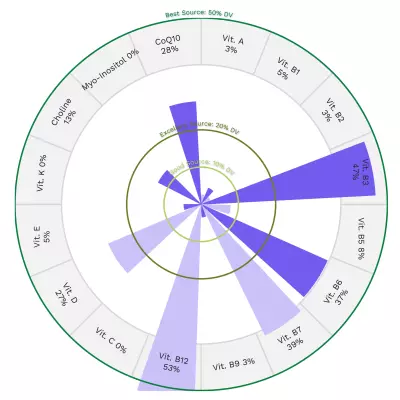
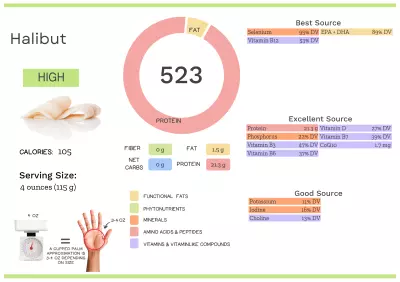

Quality Meat and Seafood
- 100% grass fed and finished beef, pasture-raised pork, pasture-raised chicken and wild-caught seafood
- Raised on regenerative family farms in the USA
- Fast delivery from our farms to your door
- Save 20% off for life, plus $15 off your first box, no coupon required
Halibut Nutrition Varies With Cooking
The Nutrivore Score of halibut varies depending on the method of preparation.
| NUTRIVORE SCORE | |
|---|---|
| Halibut, cooked, dry heat | 517 |
| Halibut, raw | 523 |
Halibut Nutrition Varies With Type
There are many types of halibut, each with its own unique taste and nutrient profile, which means their Nutrivore Scores also vary. To maximize all the benefits halibut has to offer, try incorporating different types into your diet. The way in which the fish was raised (farmed or wild-caught) also has an impact. Typically wild-caught fish have higher levels of nutrients which results in higher Nutrivore Scores, but including any type of fish in our diet, farmed or wild-caught, will result in plenty of health benefits!
| NUTRIVORE SCORE | |
|---|---|
| Halibut, Alaskan Native, raw, with skin | 574 |
| Halibut, Atlantic and Pacific, raw | 523 |
| Halibut, Greenland, raw | 457 |
Impressed by all the bene-FISH-ial nutrition in halibut? Maybe your friends will be too!
Health Benefits of Halibut Nutrients
Let’s take a closer look at all of the best and excellent source of nutrients found in a 4-ounce serving of halibut and see how they benefit our health.
Halibut Provides 95% DV Selenium
Halibut is an outstanding source of selenium, providing 95% of the daily value per 4-ounce serving!
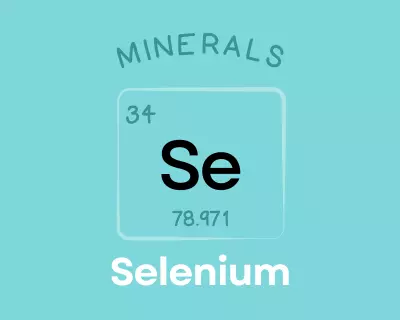
Selenium is a trace mineral needed by all mammals to sustain life. It serves as a component of the non-proteinogenic amino acids selenocysteine and selenomethionine, and also helps form over two dozen selenoproteins involved in reproduction, thyroid hormone metabolism, antioxidant defense, DNA synthesis, and immunity. Observational research suggests selenium could play a protective role against cancer, heart disease, asthma, and inflammatory bowel disease, although human trials have generally been lacking or contradictory. There’s also evidence that selenium can play a preventative role in asthma and inflammatory bowel disease, while also reducing mortality in patients with sepsis. Learn more about selenium here.
Halibut Provides 89% DV EPA+DHA
Halibut is a fantastic source of EPA+DHA, providing 89% of the daily value per 4-ounce serving!
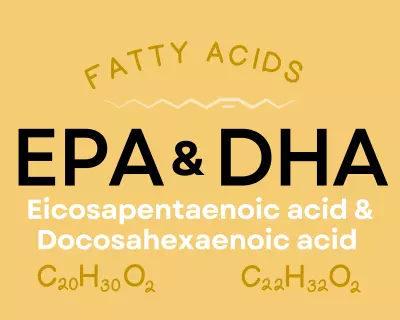
Eicosapentaenoic acid (EPA) and docosahexaenoic acid (DHA) are long-chain omega-3 fats that play important roles in neurological health, immune function, eye health and vision, inflammation, pain signaling, gut health, fetal development, and some aspects of cardiovascular health (like triglyceride levels and blood clotting). They exert many of their effects by helping form chemical messengers called prostaglandins, thromboxanes, and leukotrienes. EPA and DHA also serve as a structural component of the cell membrane, influencing important properties such as membrane fluidity and permeability. Small amounts of them can be synthesized from a shorter-chain omega-3 fat, alpha-linolenic acid (ALA). Learn more about EPA and DHA here.
Halibut Provides 53% DV Vitamin B12 (Cobalamin)
Halibut is a wonderful source of vitamin B12 (cobalamin), providing 53% of the daily value per 4-ounce serving!

Vitamin B12 (cobalamin) is a water-soluble vitamin that serves as a cofactor for enzymes involved in energy metabolism, red blood cell production, DNA synthesis, neurotransmitter production, nervous system health, and folate metabolism. As a result of these roles, vitamin B12 is vital for maintaining brain and nervous system health, and may have a protective effect against dementia, Alzheimer’s disease, and depression. There’s also some evidence vitamin B12 may be cancer-protective, possibly through supporting folate metabolism (which then assists in repairing DNA damage). Learn more about vitamin B12 here.
Halibut Provides 47% DV Vitamin B3 (Niacin)
Halibut is an excellent source of vitamin B3 (niacin), providing 47% of the daily value per 4-ounce serving!
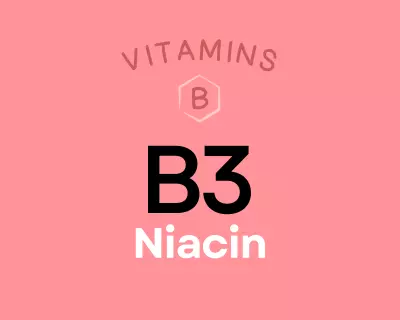
Niacin is a water-soluble B complex vitamin (vitamin B3) that’s needed to produce two very important coenzymes: nicotinamide adenine dinucleotide (NAD) and nicotinamide adenine dinucleotide phosphate (NADP). NAD and NADP are needed for over 400 enzymes involved in DNA repair, fatty acid synthesis, antioxidant systems, detoxification, and hormone synthesis, as well as the breakdown of fat, carbohydrate, protein, and alcohol. Niacin has therapeutic potential for cardiovascular disease and hyperlipidemia, and may also be protective against cancer and type 1 diabetes. Some research suggests it could benefit health outcomes for patients with HIV or schizophrenia as well. Learn more about niacin here.
Halibut Provides 21.3 g of Protein
Halibut is also an excellent source of protein, providing 21.3 g of protein per 4-ounce serving!
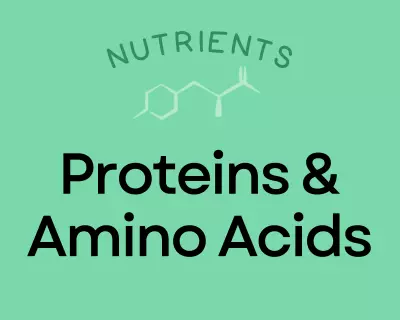
Proteins are the molecules that actually perform most of the various functions of life. In addition to being major structural components of cells and tissues, they have incredibly diverse roles from driving chemical reactions (e.g., enzymes) to signaling (e.g., some types of hormones) to transporting and storing nutrients. Dietary protein is necessary to supply the amino acid building blocks for all of the proteins in our bodies. The recommended daily allowance of protein is 0.36 grams per pound body weight (0.8 grams per kilogram of body weight). That amounts to 56 grams for a 150-pound person. However, it’s important to emphasize that this number is considered a minimum daily allotment, and there is no established upper limit. In fact, many studies have evaluated diets containing three to four times more protein than this minimum and proven benefits to weight management, body composition, hormone regulation, and cardiovascular health. These studies suggest that an optimal protein intake for most people is probably in the range of 1.2 to 1.8 grams per kilogram bodyweight (82 to 122 grams for that same 150-pound person), and that people who are very active may see the best results at even higher intake. Learn more about protein and amino acids here.
Halibut Provides 39% DV Vitamin B7 (Biotin)
Halibut is rich in vitamin B7 (biotin), providing 39% of the daily value per 4-ounce serving!
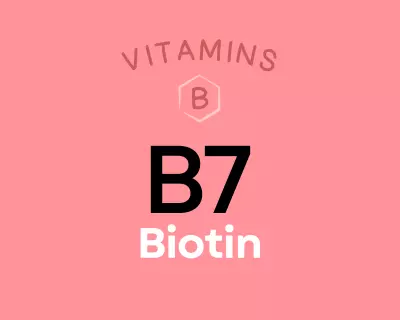
Biotin is a water-soluble B vitamin, also known as vitamin B7. Like other B vitamins, it plays an important role in energy metabolism (serving as a coenzyme for five carboxylase enzymes), neurotransmitter production, cellular function, and the function of various organs. Getting enough biotin can help support healthy nail and hair growth. It’s also particularly important during pregnancy, with low intakes increasing the risk of premature delivery and birth defects. There’s even some evidence biotin can benefit diabetics and reduce functional disabilities in people with multiple sclerosis. Learn more about biotin here.
Halibut Provides 37% DV Vitamin B6 (Pyridoxine)
Halibut is high in vitamin B6 (pyridoxine), providing 37% of the daily value per 4-ounce serving!
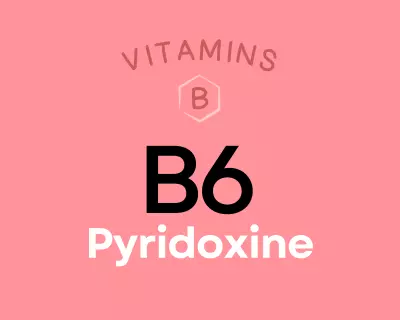
Vitamin B6 (pyridoxine) is a group of six water-soluble compounds with a similar chemical structure, all of which can be converted into their active form of pyridoxal 5’-phospate (PLP). Over 100 different enzymes require vitamin B6 in order to carry out their various functions in protein metabolism, fatty acid metabolism, neurotransmitter production, gluconeogenesis, hemoglobin synthesis, the release of glucose from glycogen, and energy metabolism (particularly the production of ATP in the Krebs cycle). Research suggests vitamin B6 may help protect against cardiovascular disease and certain cancers, could reduce the risk of depression among the elderly, and even reduce symptoms of morning sickness and PMS. Learn more about vitamin B6 here.
Halibut Provides 1.7 mg of CoQ10
Halibut is a great source of coQ10, providing 1.7 mg of coQ10 per 4-ounce serving!
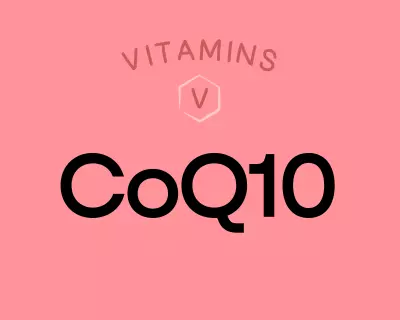
Ubiquinone is the oxidized form and ubiquinol is the reduced, more bioavailable form of the vitaminlike compound coenzyme Q10 (coQ10). CoQ10 is a potent antioxidant and a cofactor in the electron transport chain for the production of ATP. It may be helpful in treating or preventing heart and blood vessel conditions, diabetes, gum disease, muscular dystrophy, chronic fatigue syndrome, and breast cancer. Sources include beef, pork, mackerel, yellowtail fish, and chicken; it’s also found in smaller amounts in vegetables like broccoli and herbs like parsley. Learn more about coQ10 here.
Halibut Provides 27% DV Vitamin D
Halibut is also an excellent source of vitamin D, providing 27% of the daily value per 4-ounce serving!
Halibut is one of the few dietary sources of vitamin D in our modern food supply.
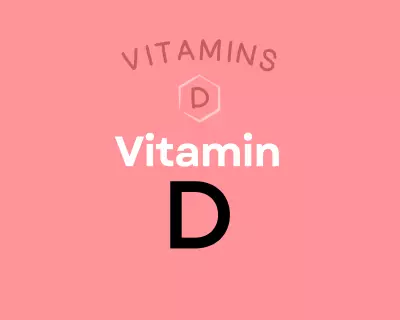
Rather than being a “true” vitamin, vitamin D is a group of fat-soluble steroid hormones that can be either obtained from the diet or synthesized from sun exposure. It plays a major role in cellular differentiation, immune function, endocrine health, cardiovascular health, and even the intestinal absorption of several other nutrients (namely calcium, magnesium, and phosphorus). As a result of these diverse functions, getting enough vitamin D is important for protecting against chronic disease (including diabetes, cancer, and degenerative neurological conditions), maintaining good gut health, and keeping a healthy immune system (including protecting against both infectious disease and autoimmunity). Learn more about vitamin D here.
Halibut Provides 22% DV Phosphorus
In addition, halibut is an excellent source of phosphorus, providing 22% of the daily value per 4-ounce serving!
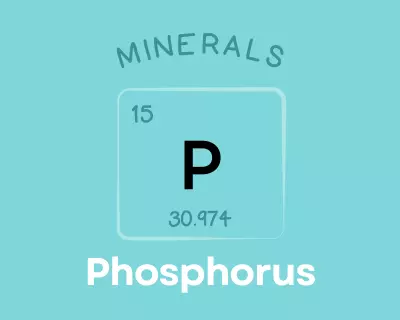
Phosphorus is an essential mineral that makes up about 1% of the total weight of the human body. Along with serving an important structural role for building nucleic acids and cell membranes, phosphorus is involved in numerous biological processes—including acid-base regulation, energy production, cell signaling, and bone mineralization. Excess phosphorus has been linked to a higher risk of cardiovascular disease, fractures, and osteoporosis, especially in the context of a low-calcium diet. Learn more about phosphorus here.
Learn What Foods Are the Best Sources of Every Nutrient

The Top 25 Foods for Every Nutrient
The Top 25 Foods for Every Nutrient e-book is a well-organized, easy-to-use, grocery store-friendly guide to help you choose foods that fit your needs of 43 important nutrients while creating a balanced nutrient-dense diet.
Get two “Top 25” food lists for each nutrient, plus you’ll find RDA charts for everyone, informative visuals, fun facts, serving sizes and the 58 foods that are Nutrient Super Stars!
Buy now for instant digital access.
How Much Halibut Should We Eat Per Day?
Fish are nutrient-dense sources of highly-digestible complete protein and outstanding sources of important nutrients in which we are commonly deficient. Let’s just say this seafood is “off the hook!” (Pun intended.)
Fish and shellfish are not only nutrient-dense sources of highly-digestible gut-friendly complete protein and the best food sources of the very important long-chain omega-3 fatty acids, DHA and EPA, but they’re outstanding sources of important nutrients in which we are commonly deficient. Eating seafood reduces risk of cardiovascular disease, type 2 diabetes, obesity and some forms of cancer.
Fish is a great source of vitamins B1, B2, B3, B6, B9, B12 and E, zinc, phosphorus, magnesium, iron, copper, potassium and selenium, with oily cold-water fish also providing substantial amounts of vitamin A and vitamin D. Fish with bones remaining, such as canned salmon and sardines, are the best dietary sources of calcium in the food supply. And marine fish are an excellent dietary source of iodine.
In fact, every 100 grams per day of seafood decreases all-cause mortality by 7%. And, every 20 grams per day of fish decreases cardiovascular disease mortality by 4%. Aim to eat three or more servings of seafood weekly (and up to every meal!). Learn more about seafood here.
It’s always best to mix up the foods you eat day to day (aiming for a wide variety of different fish and shellfish throughout the week), and halibut definitely has a place at the table.
Easily track your servings of Nutrivore Foundational Foods!

The Nutrivore Weekly Serving Matrix
The Nutrivore Weekly Serving Matrix digital resource is an easy-to-use and flexible weekly checklist designed to help you maximize nutrient-density and meet serving suggestions of Nutrivore foundational foods, all without having to weigh or measure your foods!
Includes a 22-page instructional guide and downloadable interactive guides.
Buy now for instant digital access.
cITATIONS
Expand to see all scientific references for this article.
Gormley TR, Neumann T, Fagan JD, Brunton NP. Taurine content of raw and processed fish fillets/portions. European Food Research and Technology. 2007. 225(5):837-842. doi: 10.1007/s00217-006-0489-4
Pravst I, Zmitek K, Zmitek J. Coenzyme Q10 contents in foods and fortification strategies. Crit Rev Food Sci Nutr. 2010 Apr;50(4):269-80. doi: 10.1080/10408390902773037. PMID: 20301015.
Sprague M, Chau TC, Givens DI. Iodine Content of Wild and Farmed Seafood and Its Estimated Contribution to UK Dietary Iodine Intake. Nutrients. 2021 Dec 31;14(1):195. doi: 10.3390/nu14010195. PMID: 35011067; PMCID: PMC8747335.
USDA Food Central Database: Fish, halibut, Atlantic and Pacific, raw
Watanabe T, Kioka M, Fukushima A, Morimoto M, Sawamura H. Biotin content table of select foods and biotin intake in Japanese. Int J Anal Bio-Sci. 2014. Vol 2(4):109-125.

